Physical Address
304 North Cardinal St.
Dorchester Center, MA 02124
The approach to this chapter on mucosal disease is divided along disease categories combining all regions except for the discussion of malignant masses. Because the basis for discussing cancers with clinicians is rooted in the TNM staging of the American Joint Commission on Cancer, which is itself subdivided by anatomic location, the chapter will analyze squamous cell carcinoma based on sites of origin.
An old adage avers that adding alliteration to an authoritative authorship augments educational attainment; all of us authors agree. Can you find 10 examples in this chapter?
The anatomy of the mucosal layer of the head and neck will be described along general regions of interest.
The nasopharynx is broadly defined as that area of the mucosal surface that encompasses the walls of the aerodigestive tract above the soft and hard palate and extends to the skull base. Below the nasopharynx lies the oral cavity anteriorly and the oropharynx posteriorly. The nasopharynx is lined by stratified squamous and ciliated columnar epithelium and includes the mucosa overlying the eustachian tube orifice, the cartilaginous portion of the eustachian tube (torus tubarius), and the posterolateral pharyngeal recesses known as the fossa of Rosenmüller ( Fig. 13-1 ). The mucosa of the nasopharynx is separated from the deeper retropharyngeal space by the pharyngobasilar fascia. The pharyngobasilar fascia forms a rather stiff barrier to the spread of mucosal diseases but it has bilateral openings, the sinus of Morgagni, to emit the eustachian tubes. The buccopharyngeal fascia is deep to the pharyngobasilar fascia and serves as another of the fascial barriers from nasopharynx to retropharyngeal and parapharyngeal spaces.
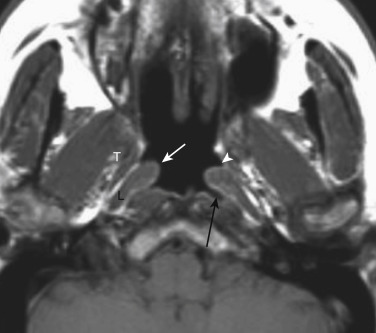
On either side of the eustachian tube orifice lie, anterolaterally, the tensor veli palatini (innervated by cranial nerve V 3 ) and posteromedially the levator veli palatini muscle (innervated by cranial nerve X), deep to the mucosa (see Fig. 13-1 ). These muscles elevate and tense the soft palate (into which they insert), preventing nasal regurgitation during swallowing. Between these muscles is a slip of fat (typically obliterated in early nasopharyngeal carcinomas) and posterolateral to these muscles lies the fat-filled parapharyngeal space, another common place to which cancer spreads. Fixate on fat—an effective friend for finding pharyngeal foulness.
The nasopharynx also houses the adenoidal lymphoid tissue. The amount of adenoidal tissue present depends on the age of the patient, because it atrophies by the fourth decade of life. In a young adult the normal adenoidal tissue and/or lymphoid hyperplasia may simulate a lymphoma or an exophytic squamous cell carcinoma. In patients who are positive for human immunodeficiency virus (HIV), on average, the width of the adenoidal tissue is twice that of age matched controls ( Fig. 13-2 ). The normal variation in adenoidal thickness requires vigilance for deep invasion, infiltration of the parapharyngeal fat, concomitant middle ear and/or mastoid opacification, and/or skull base erosion or obscuration of the planes between the tensor and levator veli palatini muscles to definitively suggest tumor. Lymphoid tissue here and in the palatine and lingual tonsils is usually slightly hyperintense on T1-weighted imaging (T1WI) and hyperintense on T2-weighted imaging (T2WI) and enhances. These imaging characteristics would be unusual for a squamous cell carcinoma but could occur in a lymphoma. The adenoids, the palatine (also known as faucial) tonsils, and the lingual tonsils make up Waldeyer ring of lymphoid tissue ( Fig. 13-3 ). All of these regions may show lymphoid hyperplasia in cases of infection or because of exposure to chronic irritants (cigarette smoke, alcohol, chewing tobacco, and mothers-in-law).
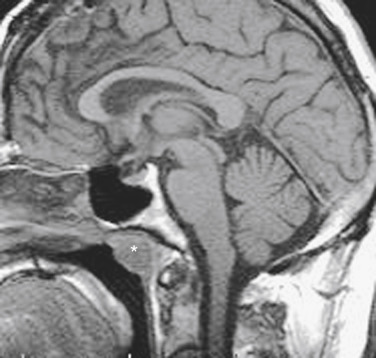
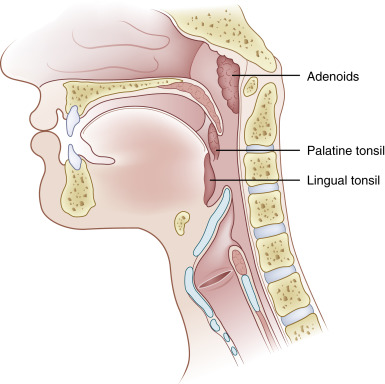
Minor salivary gland tissue is present throughout the aerodigestive system and is relatively abundant in the nasopharynx, oropharynx, and oral cavity. The hard and soft palate has the highest concentration of minor salivary glands (and consequently the highest rates of minor salivary gland neoplasms). Squamous epithelium lines the vast majority of the aerodigestive system mucosa of the head and neck.
The oropharynx includes the posterior third of the tongue (also known as the tongue base); the vallecula; the palatine tonsils and tonsillar fossa; the posterior and superior pharyngeal walls from the level of the soft palate down to the pharyngoepiglottic folds; the uvula; and the soft palate ( Fig. 13-4 ). The circumvallate papillae of the tongue separate the oral tongue (a part of the oral cavity) anteriorly from the oropharynx posteriorly. The hard palate is part of the oral cavity, but the soft palate is part of the oropharynx. Besides the palatine tonsils, the oropharynx also contains the lingual tonsillar tissue seen at the base of the tongue.
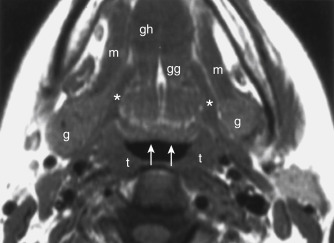
The oral cavity includes the lips, the anterior two thirds of the tongue, the buccal mucosa, the gingiva, the hard palate, the retromolar trigone, and the floor of the mouth. For the radiologist the phrase “the floor of the mouth” should be equated with the mylohyoid musculature (which constitutes the inferior sling of the mouth) and the sublingual space, between the mylohyoid muscle and the hyoglossus muscle ( Fig. 13-5 ). The lingual nerve from the trigeminal nerve and the hypoglossal nerve run together from the floor of the mouth into the tongue base and sublingual space and are important for the surgeon to identify to maintain tongue function. Radiologists must identify whether tumor is in the sublingual space, to alert the surgeon regarding the potential for invasion or sacrifice of these nerves. The chorda tympani from the facial nerve supplies taste to the anterior two thirds of the tongue and its branches join that of the lingual nerve. The glossopharyngeal nerve supplies taste to the posterior third of the tongue.
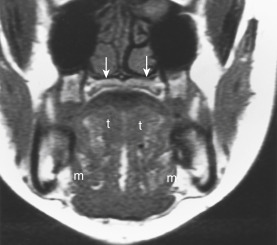
The hypopharynx is the junction between pharynx and larynx and includes three major subsites: the pyriform sinus, the postcricoid region (pharyngoesophageal junction), and the posterior pharyngeal wall above the inferior border of the cricoid cartilage ( Fig. 13-6 ). The top of the hypopharynx is at the epiglottic level, and its inferior border is the pharyngoesophageal junction. The mucosa over the posterior surface of the cricoarytenoid joints is part of the hypopharynx. The anteromedial border of the pyriform sinus is the aryepiglottic fold, a structure of the supraglottic larynx.
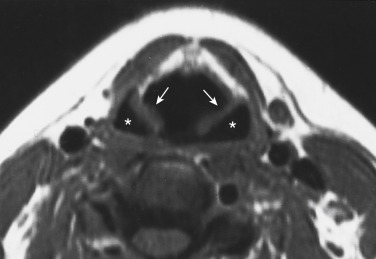
The pyriform sinus is best evaluated with the patient undergoing Valsalva maneuver because this distends the airway down to its inferiormost portion, the pyriform apex. This maneuver may be employed during barium studies or ultrafast computed tomography (CT) scans. The apposition of mucosal surfaces in the pyriform sinus often makes lesion localization difficult. You may not be able to distinguish extension to the adjacent aryepiglottic fold, the lateral pyriform sinus mucosa, or the posteromedial mucosa without such maneuvers to maximize distention.
The larynx is broadly separated into the supraglottis, the glottis, and the subglottis ( Fig. 13-7 ). Each of these areas is dealt with individually by the head and neck oncologic surgeon, although lesions often cross these boundaries of the larynx (transglottic cancers). The supraglottis includes the subsites of the false vocal cords, the arytenoids, the infrahyoid and suprahyoid epiglottis, and the aryepiglottic folds. The glottis includes the true vocal cords, the anterior and posterior commissures, and the vocal ligament extending from the arytenoid cartilage. The laryngeal ventricle is said to separate the supraglottis and glottis, but is itself a part of the supraglottis. The subglottis begins 1 centimeter below the laryngeal ventricle and extends to the first tracheal ring. The dominant structure of the subglottis is the cricoid cartilaginous ring.
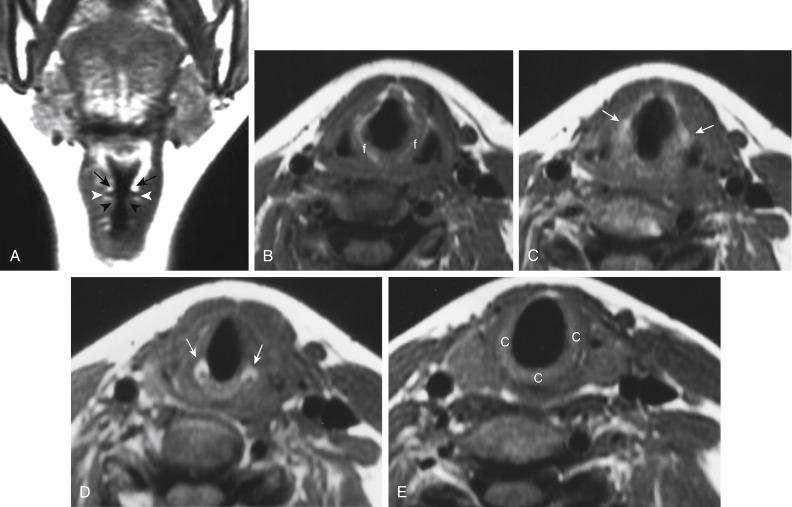
The larynx is anchored on a framework composed of the hyoid bone, the epiglottis, the thyroid cartilage, the cricoid cartilage, and the arytenoids, each of which has an integral function. Of these, the complete ring of the cricoid cartilage is the indispensable strut for preservation of airway patency. The major role of the epiglottis is to protect the airway during swallowing. From the inferior portion of the arytenoid cartilage the vocal ligament stretches to the thyroid cartilage anteriorly and supports the vocal cord. The lower cricoarytenoid joint is the marker for the level of the true vocal cord ( Fig. 13-8 ). The true vocal cords meet in the midline at the anterior commissure. This junction should be no more than 1 to 2 mm of thickness. The posterior commissure refers to the mucosa between the two vocal processes on the anterior surface of the arytenoid cartilage.
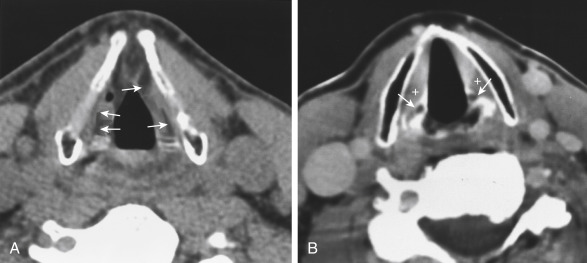
On the lateral side of the laryngeal mucosal surface is the paraglottic space, which contains fat, lymphatics, and small muscles. At the false cord level the paraglottic space is dominated by fat, whereas at the true cord level it contains the thyroarytenoid muscle, which makes up the bulk of the true vocal cord, parallels the vocal ligament, and marks the glottic level. Thus, you can tell if you are at a supraglottic level by seeing fat deep to the mucosa—at the glottic level, it is muscle that is seen submucosally. The cricoarytenoid muscle moves the arytenoids to narrow or open the glottic airway for speech.
The vagus nerve innervates the larynx through two branches: the recurrent laryngeal nerve and the superior laryngeal nerve. The only muscle supplied by the latter is the cricothyroid muscle, and its paralysis causes only minor changes in the voice. The vagus descends from the medulla through the jugular foramen into the carotid sheath. The vagus follows the carotid sheath inferiorly with the recurrent laryngeal nerve looping under the aortic arch on the left and the subclavian artery on the right, before ascending in the tracheoesophageal groove. The branches of the recurrent laryngeal nerve perforate the cricothyroid membrane to supply the functioning intrinsic musculature of the larynx.
Although the location of the following congenital lesions varies as they ascend or descend in the neck, they will be presented here more or less in a top-down order.
The most common congenital lesion of the nasopharynx (and BTW the head and neck) is the Tornwaldt cyst ( Fig. 13-9 ). This results from apposition of the mucosal surfaces of the nasopharynx in the midline as the notochord ascends through the clivus to create the neural plate. A Tornwaldt cyst usually is hypodense on CT. The intensity on magnetic resonance imaging varies with the protein content but is usually bright on T1WI and T2WI. The cyst is usually well defined and characteristically occurs in the midline, although it may be seen off midline in a small percentage of cases. The cysts become infected on rare occasions and may be a source of persistent halitosis.
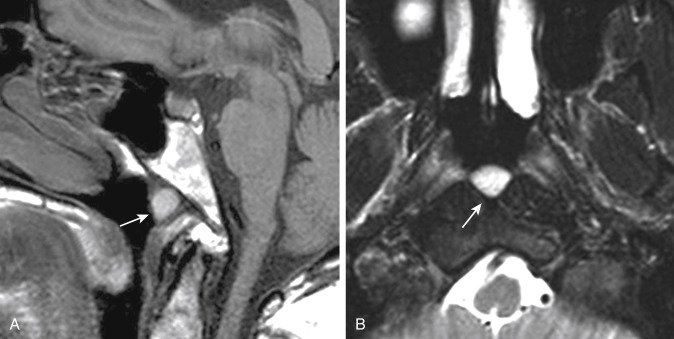
Tornwaldt cysts should be distinguished from mucus retention cysts, which are also often seen within the nasopharyngeal mucosa, and are T1 dark, T2 bright with peripheral rim enhancement.
Of the congenital cysts in the maxilla, the nasopalatine cyst (incisive canal cyst) is the most common. This cyst usually arises in the (para) midline incisive canal and slowly expands the maxilla and hard palate. Usually the cyst is painless and the teeth are unaffected. Therefore, it is not considered an odontogenic cyst.
Cherubism can occur in patients with familial fibrous dysplasia of the mandible, neurofibromatosis, Noonan syndrome (male Turner syndrome), and Ramon syndrome (cherubism, gingival fibromatosis, epilepsy, and mental retardation). The ground glass appearance and “bubbliness” akin to fibrous dysplasia are typical of this bilateral bony lesion ( Fig. 13-10 ).
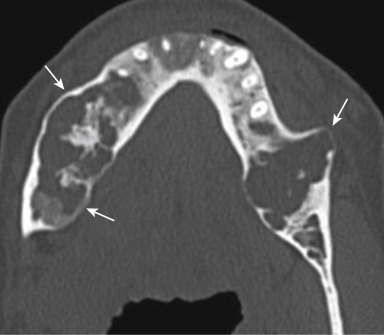
Branchial cleft cysts are not considered to be “mucosal lesions”; however, when they drain to the mucosal surface they may present as such. Second branchial cleft fistulas may drain to the palatine tonsil from their typical location deep to the sternocleidomastoid muscle but superficial to the carotid sheath (Bailey type II second branchial cleft cyst [BCC]). Those arising in the parapharyngeal space and potentially draining to the mucosa are classified as Bailey type IV second BCC.
The pyriform sinus is a drainage site for third branchial cleft cysts, and the pyriform sinus apex may be a site of sinus tracts leading from fourth branchial cleft cysts. The third branchial cleft sinus tract passes between the common carotid artery and vagus nerve to the anterior border of the inferior sternocleidomastoid muscle. The fourth branchial cleft sinus tract passes around the great vessels and the aortic arch on the left side. Pyriform sinus fistulas from the fourth branchial apparatus may pass to the thyroid gland causing acute suppurative thyroiditis or may open to the skin surface. The vast majority of these fistulas are left sided. Recurrence rates are about 40%.
Epidermoids and less commonly dermoids and lymphangiomas (usually multilocular) may occur in the aerodigestive system favoring the oral tongue and floor of the mouth. Epidermoid cysts usually occur in the sublingual space and have fluid density and signal intensity ( Fig. 13-11 ). The dermoids contain fat or fluid or other dermal appendages with density and intensity that is characteristically heterogeneous. However, more often than not, these microscopic elements are not appreciable on imaging, and both epidermoid and dermoid need to be included in the differential diagnosis. If you perform diffusion-weighted imaging (DWI) on your head and neck study you may see that epidermoid lesions may have reduced apparent diffusion coefficient (ADC). The “sac of marbles” sign refers to geometric designs within the cyst.
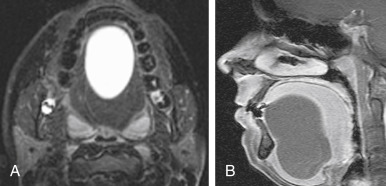
Dermoid/epidermoid cysts should be distinguished from thyroglossal duct cysts (TGDCs), which may also occur in the tongue base or floor of mouth. The classic distinguishing feature is that TGDCs are embedded within the strap musculature. TGDCs are much more common entities than lingual thyroid glands but are usually infrahyoidal. This entity is covered in the thyroid gland section of Chapter 14 .
Ectopic thyroid tissue may be seen embedded in the posterior tongue because of arrested descent from the foramen cecum (the origin of the thyroglossal duct), which is located at the junction of the two sides of the circumvallate papillae along the anterior edge of the base of the tongue. This thyroid tissue is typically in the midline, is hyperdense on noncontrast computed tomography (NCCT) because of its natural iodine content, and enhances following contrast administration. After identifying the lingual thyroid tissue, the radiologist must next image the neck for any additional thyroid gland residua ( Fig. 13-12 ). In 80% of cases the lingual thyroid tissue is the only functioning thyroid tissue in the body. These ectopic tissues are subject to the same pathologies seen in the thyroid gland proper, including tumors. Incomplete descent of the thyroid gland elsewhere in the lower part of the neck is an uncommon congenital anomaly.
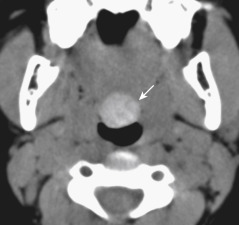
Venous vascular malformations (VVMs), with or without evidence of phleboliths, can occur anywhere in the neck, favoring the oral cavity and oropharynx for mucosal sites. They are most commonly seen in the skin and subcutaneous tissue, but populate the entire aerodigestive tract and nonmucosal spaces ( Fig. 13-13 ). Previously, these were called hemangiomas, but this term is now relegated to those neoplastic lesions that tend to spontaneously regress in childhood or in response to steroids. Forty percent of VVMs are in the head and neck, followed by the extremities and the trunk, VVMs are often dense on NCCT and enhance avidly. These mucosal lesions grow with age and are evident because of their coloration on endoscopy.

Webs can occur in the larynx, usually at the true cord level. This is due to incomplete recanalization of the airway tube. As one would expect, the children present with airway obstruction and dysphonia. This entity is associated with subglottic stenosis in one third of cases.
When subglottic narrowing is seen in an infant, the differential diagnosis is usually between a capillary hemangioma and idiopathic subglottic stenosis. Stridor suggests subglottic stenosis: scoping shows stricture sans submucosal swelling. On the other hand, the subglottic capillary hemangioma is a benign neoplasm that generally occurs in 1- to 2-year-olds. Fifty percent of patients with subglottic hemangiomas have cutaneous hemangiomas as well. This is a benign tumor that is easy to diagnose endoscopically ( Fig. 13-14 ) because of its characteristic location and red coloration. It often responds to steroid therapy, benign neglect (because it regresses with age) and/or laser therapy. In general, excisional treatment is not required except in those cases where extensive laryngeal narrowing is produced by the mass. On plain films the subglottic hemangioma causes an asymmetric narrowing of the airway of the subglottis. CT and MR reveal a smooth, enhancing mass that is asymmetric in the subglottis and that compromises the airway. In adults hemangiomas are usually supraglottic lesions.
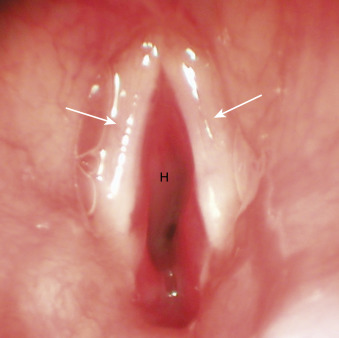
Tracheolaryngomalacia is another neonatal entity that can cause airway narrowing and that is usually outgrown with time. The children have inspiratory stridor because the floppy laryngeal cartilages collapse under the effects of negative inspiratory pressure.
Narrowings of the oropharynx can cause or be a result of obstructive sleep apnea (OSA) and Pickwickian syndrome. Pickwickian syndrome refers to morbid obesity, hypoventilation, and polycythemia. The narrowing of the airway may be due to obesity, redundancy of mucosal and muscular tissue, hypertrophy of lymphoid tissue, or on a congenital basis (hence discussed herein). In general, cross-sectional diameters of the oropharynx are reduced in patients with OSA at the soft palate, base of tongue, or uvula levels. The normal cross-sectional airway measurement should be about 100 mm 2 . Patients with OSA often have values at or below a width of 50 mm 2 and may correspond with oxygen desaturation episodes. Treatment options for OSA are varied and include behavioral modification such as weight reduction, sleep hygiene, intraoral appliances that advance the mandible, positional training, and continuous positive airway pressure (CPAP) applied via a nasal mask. Uvulopalatopharyngoplasty or other surgical interventions are reserved for those who fail conservative therapy and who experience significant deoxygenation/hypoxia in their sleep.
Typically, pharyngeal mucosal based thickening is seen in patients presenting with fever and sore throat. Because this is an easily made clinical diagnosis in the proper setting, no imaging is typically required. Nonetheless, occasionally one may find an associated peritonsillar abscess in a patient who does not respond to antibiotics for tonsillitis. The typical microorganisms that cause a tonsillar abscess include Streptococcus pneumoniae, Streptococcus viridans, and occasionally gram-negative anaerobes. Often one is dealing with multiple bugs at once.
If a fistula in the tonsil is identified, consider a branchial cleft anomaly as a possible cause. Typically, the second branchial cleft fistulas drain to the tonsil and may or may not be associated with a cystic lesion in the soft tissues of the neck near the angle of the mandible. Actinomycosis is an unusual cause of peritonsillar fistulas.
Imaging is also performed to look for complications including organized abscess formation or retropharyngeal extension of inflammation ( Fig. 13-15 ). Pharyngitis and retropharyngitis can lead to Grisel syndrome—torticollis with rotatory subluxation of C1 on C2 secondary to an adjacent inflammatory mass. More often, one sees retropharyngeal lymphadenitis because of pharyngitis or tonsillitis.
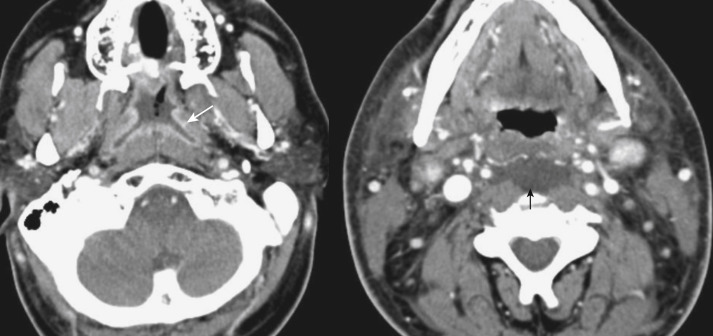
Calcifications in the adenoids and tonsils (tonsilloliths) are not uncommon after infections. They simply symbolize sequelae of successful solution of such sickness. These are of no import and do not implicate granulomatous infections.
Abscesses have low-density centers and a peripheral rim of enhancement on CT. Adjacent inflammation of the fat may be due to neighboring cellulitis, myositis, and fasciitis in the neck. On MR, inflammatory lesions are very bright on T2WI because of the marked amount of edema and swelling associated with lesions such as abscesses. As in the brain, the DWI of a neck abscess may show restricted diffusion. A peritonsillar location is the most common site of abscess in children, followed by the retropharyngeal region. More often, what one is calling a retropharyngeal abscess is really necrotizing retropharyngeal lymphadenitis caused by pharyngitis or tonsillitis and need not be drained surgically. If the collection crosses the midline, call it an abscess. If paramedian along the expected location of retropharyngeal nodes, call it necrotizing adenitis. A phlegmon can be considered an immature abscess that can be arrested with early appropriate therapy.
Submucosal cysts that occur in the nasopharynx ( Box 13-1 ) as sequela of previous infections are most often seen around the fossa of Rosenmüller. These cysts usually have low signal intensity on T1WI and high signal intensity on T2WI. Lymphoid hyperplasia can occur as a response to inflammation in adjacent regions. When this is seen, check for pharyngitis or tonsillitis in children, mononucleosis in hormonally active teenagers, HIV infection in adults, and cigarette butts in the ashtrays of your waiting room. Calcifications in the lymphoid tissue of Waldeyer ring, including the adenoids, are not uncommon. They simply symbolize sequelae of successful sanatory of such sickness.
Adenoidal hypertrophy (e.g., HIV)
Pharyngitis
Infected Tornwaldt cyst
Mucous retention cyst/submucosal cysts
Infectious mononucleosis
Retropharyngeal abscess/adenitis
HIV, Human immunodeficiency virus.
Lymphadenitis refers to inflammation of lymph node(s). This can be reactive, as a response to adjacent infectious process such as pharyngitis. Primary inflammation/infection of the lymph node(s) can also occur. Enlargement, abnormal enhancement, intranodal cystic/necrotic change, calcifications, and perinodal stranding should alert you to the presence of lymphadenopathy, although the cause is not always clear without the clinical context and biopsy. Children seem to have a predilection for dramatic adenitis. Posterior triangle reactive adenopathy often accompanies the ubiquitous middle ear infections of young childhood.
The classic cause of an inflammatory cervical adenitis is tuberculous adenitis (scrofula), usually seen in Southeast Asians. The patients have painless posterior neck masses with or without systemic symptoms. The source of the infection is usually contaminated milk associated with Mycobacterium bovis, causing a subclinical pharyngitis. In the United States Mycobacterium tuberculosis is the most common cause. Atypical mycobacteria ( Mycobacterium scrofulaceum especially) may also cause tuberculous adenitis. Concomitant pulmonary tuberculosis is relatively uncommon. The disease manifests as bilateral low-density necrotic lymph nodes, often in the level V posterior triangle distribution ( Fig. 13-16 ). The nodes often have ringlike thick enhancement and appear multiloculated. Adjacent fat planes are obscured or edematous. The nodes often calcify after treatment ( Box 13-2 ). The differential diagnosis of calcified nodes should include tuberculosis, other granulomatous diseases (fungi, sarcoidosis, and Thorotrast granulomas), amyloid, treated lymphoma, anthracosilicosis, and metastatic thyroid carcinoma, adenocarcinoma, and squamous carcinoma.
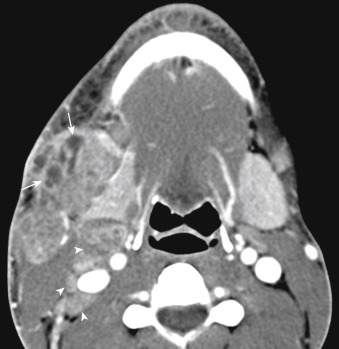
Tuberculous adenitis
Granulomatous (nontuberculosis) infections
Rarely inactive (burnt-out) inflammatory nodes
Thyroid metastases
Mucinous adenocarcinoma metastases
Amyloid
Radiated lymph nodes
Thorotrast
Castleman disease (angiofollicular hyperplasia) is a nodal disease that can be seen in the chest (70% of cases) and the head and neck (10%). Usually the patient is asymptomatic and younger than 30 years old. The unique feature of these nodes is their avid enhancement because of hypervascular stroma ( Fig. 13-17 ). The nodes are nonnecrotic. There may be a stellate area of nonenhancement in the center of the enhancing nodes.
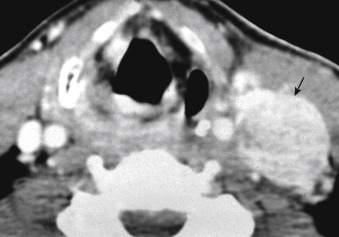
Mononucleosis, caused by Epstein-Barr virus (EBV) infection, is another inflammatory source of multiple enlarged nonnecrotic lymph nodes. The differential diagnosis includes but is not limited to acquired immunodeficiency syndrome (AIDS) and sarcoidosis. In AIDS and mononucleosis the lymphoid tissue of Waldeyer ring (adenoids, palatine tonsils, and lingual tonsils) may be hypertrophied and bilateral nodes are the rule ( Fig. 13-18 ). If intraparotid lymphoepithelial cysts are present, HIV infection is more likely. If the parotid glands are enlarged and infiltrated diffusely, sarcoidosis may be suggested but a chest radiograph with bihilar adenopathy may be the best clue. Otherwise the differential diagnosis may rely on serology or the appropriate (kissing) history.
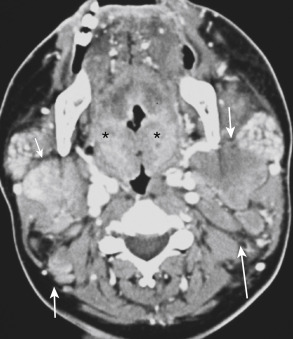
Another “zebra” that can cause bilateral lymph nodes, including intraparotid nodes, is cat scratch fever. There often is edema surrounding the nodes. The etiologic agent in this infection has recently been characterized as a gram-negative intracellular bacterium (Bartonella henselae). If you quiz the clinician about a cat scratch history and actually come up with the diagnosis, you will be a star in his or her eyes forever. It is a self-limited disease that may manifest regional lymphadenopathy, fever, and malaise, but can progress to encephalopathy and neuropathy after a cat scratch or flea bite. Parinaud oculoglandular syndrome, characterized by unilateral conjunctivitis with polypoid granuloma of the palpebral conjunctiva, and preauricular, parotid, and periparotid lymphadenopathy can be caused by Bartonella infections. The diagnosis is confirmed by positive serologic tests or positive polymerase chain reaction assays to the bacterium.
Sinus histiocytosis may cause massive nodes. The eponym is Rosai Dorfman disease and the disease presents with painless, bilateral, cervical lymphadenopathy accompanied by fever, leukocytosis, and elevated serum inflammatory markers. The nodes usually resolve as the disease is self-limited.
Kikuchi disease, histiocytic necrotizing lymphadenitis, predominantly affects young adults of Asian ethnicity. The etiology is unclear, but is probably viral, and the patients present with adenopathy, fever, and leukopenia. It is associated with large necrotic and nonnecrotic, enhancing and nonenhancing adenopathy. The CT appearance of Kikuchi disease can simulate lymphoma and other nodal diseases that have necrosis, such as metastasis and tuberculosis. Be Kareful not to Miss Kikuchi!
Kimura disease is another import from Asia. It is a chronic inflammatory process with associated diffuse hypervascular adenopathy in the cervical chains favoring the submental and submandibular regions, eosinophilia, and a predilection for Asian men aged 10 to 30. The salivary glands may be swollen and tender. The nodes are round, solid, hypoechoic, and homogeneous. They have hilar hypervascularity on power Doppler scans (hey, since this is an Asian import, the sonographic features are what is best known about the disease).
Posttransplant lymphoproliferative disorder (PTLD) is one of those cross-over diseases between a reactive node, a benign neoplasm, and a malignant neoplasm. The aggressiveness of the entity ranges widely from benign lymphoid hypertrophy to myeloma, to monoclonal lymphomas, to polyclonal lymphomas, all from the EBV leading to B-cell proliferation. Basically, you can find enlarged nodes in the abdomen, chest, and neck (in descending order of frequency) in patients after whole organ transplants (heart, liver, kidney, or bone marrow). The inciting event appears to be an infection by Epstein Barr virus, leading to a proliferation of B cells. If the T cells are deficient, as in transplant patients or HIV infections, this B-cell mass production gets revved up. Although this may result in a polyclonal lymphoproliferation, if unabated, a monoclonal dominant spike may appear. In some of these patients, lymphoma develops; in others the adenopathy resolves with manipulation of medications to produce a reduction in the degree of immunosuppression. Chemotherapy may be required in some. PTLD can affect the adenoids and tonsils and is usually seen after solid organ transplantations (lung is most common). The onset of this process may range from months to years after the transplant.
Become a Clinical Tree membership for Full access and enjoy Unlimited articles
If you are a member. Log in here